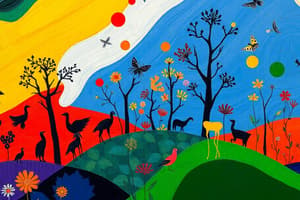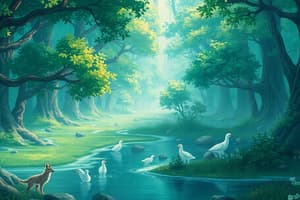Podcast
Questions and Answers
What is a biome?
What is a biome?
- A large, relatively distinct terrestrial region with similar climate, soil, plants, and animals. (correct)
- A marine ecosystem with varying abiotic factors.
- A region characterized by extreme weather changes.
- A small, distinct terrestrial region with different climate, soil, plants, and animals.
Which of the following is a characteristic of the Arctic tundra biome?
Which of the following is a characteristic of the Arctic tundra biome?
- Boggy plains covered by lichens and mosses. (correct)
- Forest-covered lands with moderate temperatures.
- Tropical climate with abundant rainfall.
- Warm winters and long summers.
What is the primary factor influencing the distribution of biomes?
What is the primary factor influencing the distribution of biomes?
- Temperature and precipitation. (correct)
- Vegetation type.
- Geographical size of the biome.
- Human population density.
How do chaparral vegetation removal practices impact soil stability?
How do chaparral vegetation removal practices impact soil stability?
Which of the following best describes an abiotic factor in an ecosystem?
Which of the following best describes an abiotic factor in an ecosystem?
How do harsh, cold winters and extremely short summers characterize the Arctic tundra?
How do harsh, cold winters and extremely short summers characterize the Arctic tundra?
What is the main difference between a community and an ecosystem?
What is the main difference between a community and an ecosystem?
Which of the following is considered an abiotic factor in an ecosystem?
Which of the following is considered an abiotic factor in an ecosystem?
Why are organisms in a coral reef ecosystem driven to live in that environment?
Why are organisms in a coral reef ecosystem driven to live in that environment?
What defines a landscape?
What defines a landscape?
Which of the following is NOT an abiotic factor in an ecosystem?
Which of the following is NOT an abiotic factor in an ecosystem?
Why is a watershed considered a convenient landscape-level unit for study and management?
Why is a watershed considered a convenient landscape-level unit for study and management?
What is the typical vegetation found in the emergent layer of a tropical rainforest?
What is the typical vegetation found in the emergent layer of a tropical rainforest?
Which abiotic factor characterizes the Chaparral biome?
Which abiotic factor characterizes the Chaparral biome?
What type of plants are commonly found in the understory of a tropical rainforest?
What type of plants are commonly found in the understory of a tropical rainforest?
Which animal is most likely to be adapted to living in the canopy of a tropical rainforest?
Which animal is most likely to be adapted to living in the canopy of a tropical rainforest?
What abiotic factor characterizes the Temperate Grassland biome?
What abiotic factor characterizes the Temperate Grassland biome?
Which type of fauna is commonly found in Scrub Oak vegetation?
Which type of fauna is commonly found in Scrub Oak vegetation?
Flashcards are hidden until you start studying
Study Notes
Community and Ecosystem
- A community is composed of two or more populations of different species occupying the same geographical area.
- Populations and communities only include biotic factors.
- An ecosystem is a community and its abiotic factors (e.g., soil, rain, temperature, and nutrients) functioning together.
Ecosystem Example
- Coral reef in Talikud Island is an ecosystem with a community of fishes, invertebrates, corals, algae, bacteria, and planktons.
- The community is driven to live in this environment because their needs are met, such as quality of sunlight, pH, nutrients, salinity, temperature, and water as their habitat.
Landscape
- A landscape is a heterogeneous area composed of a cluster of interacting ecosystems repeated in a similar manner throughout.
- A watershed is a convenient landscape-level unit for large-scale study and management, having identifiable natural boundaries.
Biome
- A biome is a large, relatively distinct terrestrial region with similar climate, soil, plants, and animals, regardless of where it occurs in the world.
- A biome encompasses many interacting ecosystems and is the next level of ecological organization above community, ecosystem, and landscape.
- Temperature and precipitation have a predominant effect on biome distribution.
Types of Biomes
Tundra
- Treeless biome in the far north with harsh, cold winters and extremely short summers.
- Characteristics: boggy plains covered by lichens and mosses.
Tropical Rainforest
- Emergent layer: very tall trees (up to 50m or 164ft).
- Middle story or canopy: trees 30 to 40m (100 to 130ft) tall.
- Smaller plants in the sparse understory.
- Communities of epiphytic plants such as ferns, mosses, orchids, and bromeliads.
- Fauna: sloths, monkeys, abundant and varied insects, reptiles, and amphibians.
Chaparral
- Biome with mild, moist winters and hot, dry summers.
- Vegetation: small-leaved evergreen shrubs and small trees.
- Soil is thin and often not very fertile.
- Wildfires occur naturally, particularly frequent in late summer and autumn.
- Flora: scrub oak.
- Fauna: mule deer, wood rats, chipmunks, lizards, and many species of birds.
Temperate Grassland
- Grassland with hot summers, cold winters, and less rainfall than in the temperate deciduous forest biome.
Studying That Suits You
Use AI to generate personalized quizzes and flashcards to suit your learning preferences.




